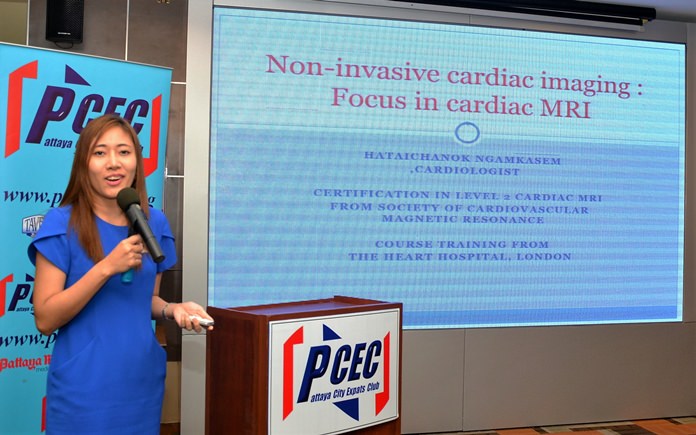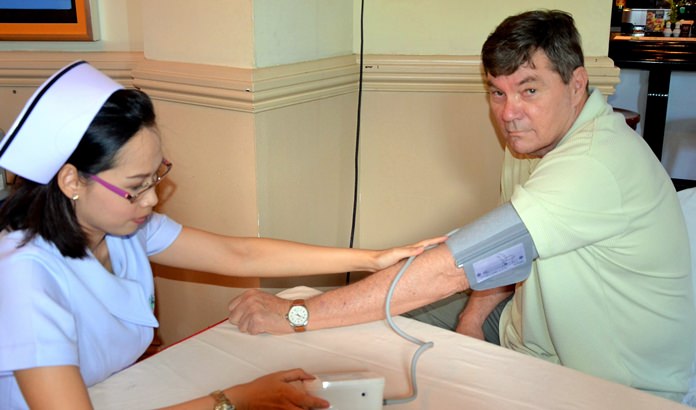A picture of your heart tells the doctor a lot when diagnosing possible heart problems. Dr. Hataichanok Ngamkasem, Cardiologist, from Phyathai Hospital Sriracha was the guest speaker at the June 19 meeting of the Pattaya City Expats Club. She talked about the differences among non-invasive cardiac imaging techniques, such as electrocardiogram (EKG), echocardiogram, nuclear camera images, Cardiac CT scan and Cardiac MRI.

Dr. Hataichanok said cardiac imaging techniques are safe and easy to perform. When a patient presents a symptom, cardiac imaging can take a picture of your heart to confirm the doctor’s diagnosis. She described common symptoms that may require testing include chest discomfort, shortness of breath, lightheadedness, dizziness and fatigue. In some cases, symptoms might include pain in the jaw, left shoulder or left arm. She said she has seen cases in which a person goes to the dentist with jaw pain, but dies because they were actually having a heart attack.
Dr. Hataichanok identified three goals of cardiac testing: (1) to identify or exclude various forms of heart disease as a reason for a person’s symptoms; (2) to establish the risk of developing future heart disease such as a heart attack; and (3) to decide on the need for additional medical therapies and procedures.

Although not a cardiac imaging test, she mentioned that usually the first step is a treadmill test, which produces an electrocardiogram (EKG) showing electrical activity of the heart during rest and exercise. But some people, especially if they’re overweight or out of shape, can’t do a treadmill or those the stress test shows abnormalities, need to proceed to other cardiac imaging techniques.
An echocardiogram produces images of heart muscle and valves function. It provides basic information of the cardiac chamber size and contraction function, areas of myocardial infarction, heart muscle disease and pericardial disease. Further, she explained it is the best diagnostic tool for valvular heart disease. Pros of an echocardiogram are that it is non-invasive, convenient, and low cost. Cons are variations in resolution and image quality, and the fact that it cannot exclude myocardial ischemia or artery disease, can’t detect myocardial viability, and can’t differentiate between types of heart muscle disease. It also might not produce good results with a big person who has thick chest muscles.

A nuclear camera produces images showing blood flow to the heart muscle. Dr. Hataichanok did not go into detail on this type of imaging, but according to the American Heart Association Website, Single Photon Emission Computed Tomography (SPECT) does a scan of the heart and is a non-invasive nuclear imaging test. It uses radioactive tracers that are injected into the blood to produce pictures of your heart. A special “gamma” camera picks up signals from the tracer as it moves around your chest. The tracer’s signals are converted into images by a computer. Doctors use SPECT to diagnose coronary artery disease and find out if a heart attack has occurred. SPECT can show how well blood is flowing to the heart and how well the heart is working.
A Cardiac CT (Computed Tomography) scan produces images showing calcium build-up in the arteries that supply blood to the heart muscle. It is the best diagnostic tool for coronary artery disease. Pros of a CT scan is that it provides a good visualization of the coronary arteries, and it is suitable for high risk patients such as those that smoke or have diabetes or hypertension. Cons are radiation and radiocontrast exposure, and the fact that it cannot provide valvular and heart muscle information. Sometimes a CT scan can cause problems with a person’s kidneys because of the dye that is injected during the procedure.
A Cardiac MRI (Magnetic Resonance Imaging) produces images showing the heart muscle and scar tissue related to disease. The images tell how much of the area has low blood supply. An MRI is the best diagnostic tool for cardiac function, Ischemia testing and myocardial disease. It is also suitable for revascularization (Bypass, Balloon). Pros are that it has good resolution, no radiation or radiocontrast exposure. Cons are that it takes a long time – around 45-60 minutes, during which the patient must lie still and follow instructions such as when to hold their breath. Some patients get claustrophobia because of the closeness of the chamber. An MRI might not be safe if you have a ferromagnetic substance such as a pacemaker.
In answer to questions from the audience about whether someone with a heart condition can safely take Viagra. Dr. Hataichanok said Viagra can cause hypotension (low blood pressure), especially if it is taken by someone who takes nitrates for their condition, such as nitroglycerine tablets or spray. She recommended that you should see a doctor and do a treadmill test before taking Viagra. (Most medical websites caution against taking sildenafil (Viagra), tadalafil (Cialis), or vardenafil (Levitra) if you are taking a nitrate; combining these two drugs can cause a life-threatening drop in blood pressure). She also recommended that people shouldn’t take aspirin on a regular basis unless it’s absolutely necessary, because the risk of gastro problems can be greater than the benefits.
After the presentation, MC Roy Albiston brought everyone up to date on club activities and happenings around Pattaya before calling on Ira Wettenstein to conduct the Open Forum, where questions are asked and answered about Expat living in Thailand, especially Pattaya.
For more information on the PCEC’s many activities, visit their website at www.pcecclub.org.




